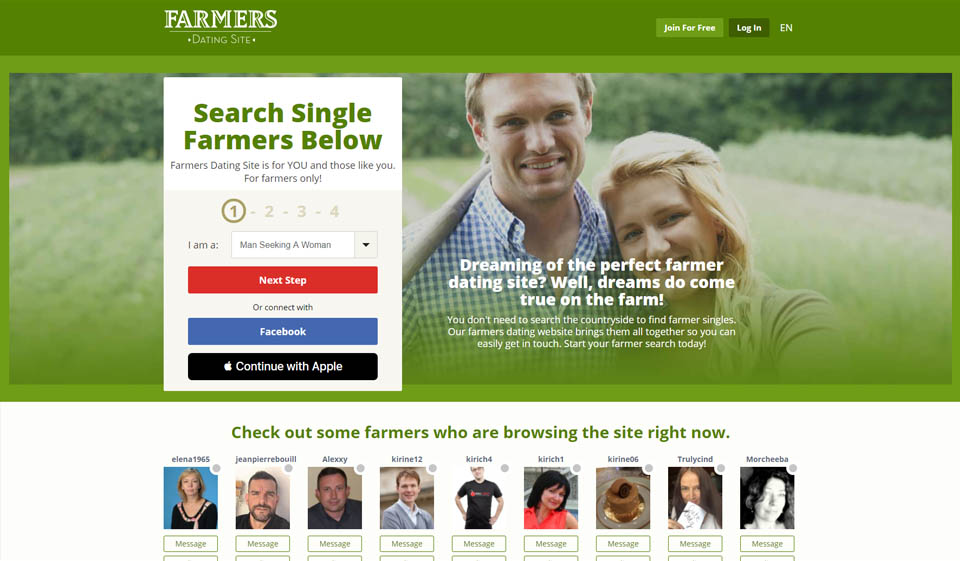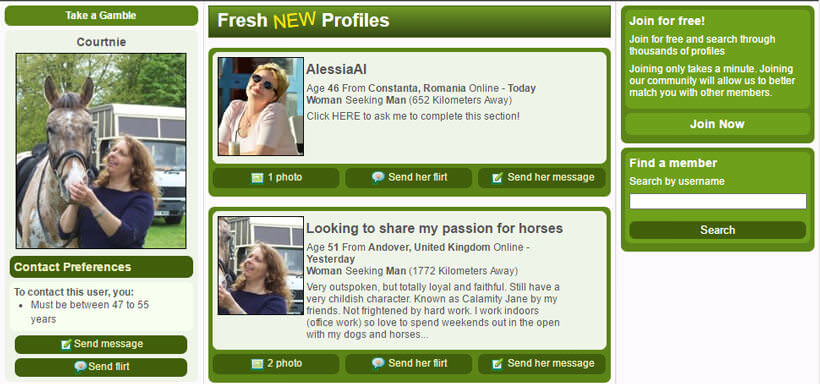Farmers Dating
Perfect Farmer is part of the dating network, which includes many other general and farmer dating sites. As a member of Perfect Farmer, your profile will automatically be shown on related farmer dating sites or to related users in the network at no additional charge. Farmer Dating Club is part of the dating network, which includes many other general and farmer dating sites. As a member of Farmer Dating Club, your profile will automatically be shown on related farmer dating sites or to related users in the network at no additional charge. Best Farmers Dating Sites: Top-5. Farmers Dating Site - was established in 2009 and successfully operates now. Usually on large dating sites it is hard to get enough attention from other participants. This is due to too many participants with similar profiles, against which it is difficult to stand out.
FarmersD - Free Farmers Dating Site & App for Farmers Only. FARMERSD is the Dating App for farmers only, which helps country singles, rural singles, cowboys, cowgirls, ranchers, horse lovers and country folk to find real love and relationships. 100% Verified Users We want to keep it simple and real, all the users are verified so you can swipe. Farmer Dating Club is part of the dating network, which includes many other general and farmer dating sites. As a member of Farmer Dating Club, your profile will automatically be shown on related farmer dating sites or to related users in the network at no additional charge. For more information on how this works, click here. Support; FAQ/Help.
Among numerous dating websites on the internet, Farmers Dating Site stands out as one of the best. Read this Farmers Dating Site review to find out why new members are joining the site every day. '>9.8/10 |


In the sea of dating websites, there is finally a site that caters to farmers and people who are into the country lifestyle. If you are a single farmer or just looking to meet one, this might be the right place for you. Take a look at our Farmers Dating Site review and find out more about this new but fast-growing website.
First Impression

We have to say that our first impression of Farmers Dating Site was a very positive one. It’s one of the nicest looking niche dating websites we’ve seen in a while, and despite the fact it’s relatively new, it looks like a legitimate website with plenty of cool users to meet and talk to. This website is obviously all about farmer dating but even if you are not necessarily a farmer, it will make you feel right at home. A warm, outgoing and friendly place, which is clear from the moment you first enter Farmers Dating Site.
Design And Functionality
Farmers And Ranchers Dating
As we mentioned earlier in this Farmers Dating Site review, this is a really nice-looking website. Dating websites, especially if they are created for a group of people sharing certain interests or backgrounds, sometimes tend to be a bit too basic and even old-timey, but that’s definitely not the case with Farmers Dating Site. It’s not a particularly elaborate website either, meaning the creators obviously managed to find that perfect balance when it comes to design. It’s simple yet effective, not at all cluttered, but not poor-looking either. The dominant color scheme is, of course, green, and there are some photos too, with nice looking couples in a country setting.
Farmers Dating Site is also very easy to use. It’s not a complicated website and it doesn’t have that many features, so everyone should be able to get a handle on it in no time, even people who are not exactly well-versed in terms of Internet and dating websites. The website has great functionality and runs very smoothly.
Join Farmers Dating Site And Start Dating TodayFeatures
As we already stated, Farmers Dating Site doesn’t have too many features, but it does have the essentials. E-mailing, chat, and instant messaging (IM) are the options you have when it comes to communicating with other users. Some dating websites don’t even have IMs or chat rooms, so it’s fair to say that in this department, Farmers Dating Site did quite well.
Farmersonly Dating Site
There is also the option of sending flirts to other users. Flirts are a cool feature that some of the best farmer dating websites have, and it’s a great and fun way to let a person know you like them and want to get to know them better. Since they do not involve any direct communication, these flirts are ideal for users who are a bit shy or introvert.
Farmers Dating Site also has a feature called The Little Black Book. In this “book,” you can add all the users you like and would like to get to know better, provided you get their consent. Once they approve of you adding them to your Little Black Book, you will have access to some extra info and even some private pictures.
Another cool feature is the “not interested” feature. When you check the “not interested” box next to a user’s profile picture, that person will no longer be able to contact you. This is a great way for everyone to feel safer and more relaxed.
However, note that not all features are available to everyone. Users with a free account can only create a profile with a picture, search for users in their area, and receive IMs and flirts. To gain access to other features, you will have to upgrade to the premium account.
/https://www.thestar.com/content/dam/thestar/news/canada/2014/04/21/single_in_the_country_online_dating_site_for_farmers_comes_to_canada/chelsea_and_daniel_sietz.jpg)
Members
Farmers Dating Site has a small but active community of members. Women are in a slight lead here, but there are plenty of guys as well. Most of the users are from the United States. Users are generally pretty active around the clock, although the site is the busiest in the evening hours.
There are little to no fake or spam accounts on this website and the crowd is generally very easy going, fun, and eager to meet new people.
Closing Word
As you can see from our Farmers Dating Site review, this is a very cool new place to meet single farmers. It’s nicely designed, highly functional, and has some pretty cool features. Whether you are a single farmer or just someone who’s into the lifestyle, you should definitely give this site a try.
Childcare in 19th century England
UHP
The term “baby farmer” is a pejorative one that came into use only in the latter half of the nineteenth century. It referred to a person, usually a woman, who took in and cared for the children of other women. This kind of paid fosterage of children had a long history, but it exploded both as an industry and a subject of concern only with the rise of urbanism and all its attendant difficulties in the nineteenth century.
Before the advent of safe and reliable contraception, many women found themselves pregnant with children they could not care for. Sometimes the social stigma of unwed motherhood caused a woman and her family to place an illegitimate child in the home of a paid caregiver. For those whose families did not have the means to pay for such an arrangement, the situation was more complicated.
In England, the Poor Law Amendment Act of 1834 prohibited parishes from granting unwed mothers what was called “outdoor relief.” Poor unwed mothers could be given food, money, or clothing from the parish only if they went to live in the workhouse. Workhouses provided a bleak existence for mother and child alike. Not surprisingly, many of the women eligible for workhouse placement chose to place their children elsewhere so that they could continue to work and earn money – outside of the workhouse.
This system worked well in theory for both participants. The mother was freed to earn money that she used to pay for the child’s care as well as her own expenses. The nurse, in turn, earned a small weekly sum herself while remaining at home and caring for her own family. Such a nurse might take in more than one child for paid care to increase her income.
This form of childcare did not raise concerns for many years. Fosterage and wet nursing had long played a role in English child rearing. Many married middle class parents placed their youngest children with a wet nurse in a country setting for the infant and toddler years. Jane Austen, who certainly did not come from an impoverished background, lived her first few years in the village home of her nurse. A home in the countryside was widely regarded as healthier for very young children.
In fact, throughout the 19th century, a country childhood was a healthier childhood. Rapid industrialization had made city life unpleasant and unhealthy. Air quality in particular declined during this period (the famous yellow fog of London was actually pollution as coal came into use both for home heating and industrial use). In London, the Thames was an open sewer with untreated human waste and the contamination of drinking water led to epidemics of cholera, typhus, and typhoid among city residents.

Farmers Dating Site Phone Number
The same American baby above, now healthy, weeks after his rescue.Farmers Dating Sight
Fostering children in the countryside worked for many years in part because the mother often held a job nearby as a servant. This allowed her both to know the nurse who cared for her child and to visit the child often enough to observe its care.
But, from the mid-nineteenth century on, industrialization and urbanization combined with stagnant wages to create a different type of fosterage. Beginning in this period, advertisements looking for children to foster or “adopt,” as well as ads searching for a place for newborns, proliferated.
Because the countryside was universally regarded as healthier, mothers preferred nurses whose homes were in the countryside. At the same time, the mothers preferred to work in the city, where wages were higher and the opportunities for work more plentiful. As a result, more and more women placed their children in villages and towns that were some distance from their places of work. Thus, complete strangers cared for children in villages and small towns with little oversight by the mothers.
The form of payment also changed. While some nurses continued to ask for a weekly sum from the mother to cover food, clothing and expenses, others demanded a lump sum as payment for the child’s care. The lump sum, sometimes five or ten pounds, was paid up front. The dangers of such an arrangement are obvious, but a young woman with an illegitimate child was often desperate to place the child and return to work. Those who asked for a lump sum sometimes used the term “adoption” to justify their demands and clarify their relationship to the child. Since adoption was completely unregulated during this period, this informal set up came under no scrutiny.
Newborns were frequently sent away from their mothers as soon as the mothers could rise from the childbed. These infants missed out on breastfeeding: they were bottle-fed cow’s milk, sugar-water, and other less than ideal liquids (specially devised feeding formulas that mimic the nutritional value of breast milk were not invented until the twentieth century). Poor diets undoubtedly contributed to the mortality rate of many of the newborns placed with these nurses.
But not all nurses were well intentioned. Some simply allowed the children under their care to die of neglect – starving them or willfully feeding them as little as possible to save on expenses.
The most notorious cases, however, involved female farmers who took in infants with the express intention of murdering them once payment was made. In some of these cases, the consigning parent understood that the infant was to be “disposed of” but in most the mother genuinely believed that she was placing her child with a caring nurse.
Margaret Waters typified the infamous “baby farmer,” who came to be so vilified in the press. Widowed in 1864, Waters turned to baby farming to earn a living. It appears that initially she charged about ten pounds to take in an infant. She then passed the infant on to another farmer, paying that farmer eight pounds or so. This enabled her to pocket the two pounds, a substantial sum, for herself.
Eventually, she was caught. The testimony of the policeman who entered her home makes it clear that her intention was to kill the children. 'Some half-dozen little infants lay together on a sofa, filthy, starving, and stupefied by laudanum,' he stated.
At least sixteen children are known to have died at her hands, many other deaths are suspected. The babies rescued by the police and turned over to the parish workhouse almost all died as a result of their time with Ms. Waters. She was tried for murder, convicted, and condemned to hang. Her execution, which took place on October 11th, 1870, was the first conviction and execution of a baby farmer in England.
Waters’ trial and conviction inspired several members of Parliament to put forward the Infant Life Protection Act of 1872. This Act attempted to protect the most vulnerable children in England: illegitimate infants who were farmed out to strangers to be raised, or, all too often, planted in their graves.